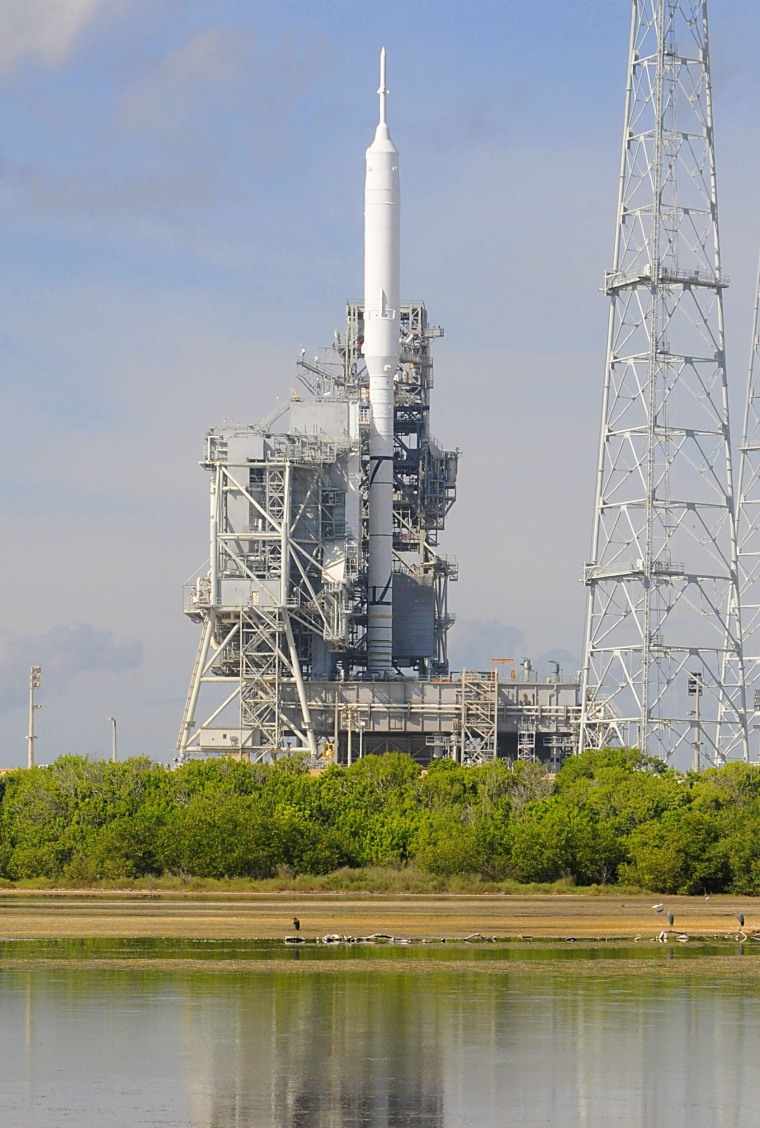NASA's first flight test of its Ares I-X booster is only slated to last two minutes, but it represents the culmination of years of work by the rocket-minded ATK Space Systems in Utah and almost 1,000 other NASA workers and private contractors across 17 states.
To ensure that they see the fruits of their labor, technicians have installed more than 700 sensors on the $445 million Ares I-X test vehicle. That electronic swarm should provide engineers with a smorgasbord of flight data, and has led to a few jokes regarding the sensor-studded rocket.
"It's almost like flying a Christmas tree," said Trina Patterson, a spokesperson for ATK Space Systems, an aerospace company based in Magna, Utah. The rocket is set launch at 8 a.m. EDT Tuesday from NASA's Kennedy Space Center in Florida.
ATK has good reason to want that data because it produced the first rocket stage that plays the undeniable starring role in the upcoming launch. Its story represents just one out of many involved in the U.S. space agency's first small step back to the moon with its tallest rocket — the 327-foot Ares I-X — in more than 30 years.
From the ashes
ATK drew partly upon heritage technology and lessons from the shuttle era, based on a history of making solid rocket boosters for the space shuttle program. It also placed safety first following the fallout from the 2003 shuttle Columbia tragedy — speed of production and cost still came in second.
"We have balanced all of those things to the point where safety was always the deciding factor," said former NASA astronaut Charlie Precourt, vice president and general manager of ATK Space Launch Systems.
Four of the five segments in the first stage represent would-be shuttle boosters dating back from when the Columbia disaster put a temporary stop on shuttle flights. NASA shipped the segments back to Utah, where they sat unused and exceeded their technical shelf life of five years.
But ATK ran tests on the segments and found them still remarkably healthy. Managers eventually decided to give them new life as part of Ares I-X.
Simplify, simplify
Engineers made the first stage design with simplicity as a guiding philosophy and were rewarded when the initial ground firing tests only turned up two minor glitches directly related to the rocket. They modified the segments, reshaped the propellant mold, and adjusted the nozzle area to allow for more power.
ATK also produced three giant parachutes that will help bring the first stage back down to Earth. Tests with single and triple parachute drops from Air Force C-17 cargo planes at Yuma Air Base in Arizona all went smoothly.
Precourt recalled that some senior ATK employees familiar with the shuttle program hesitated at first when Ares came onto the drawing board. But now they want to do it again.
"They've been pulling all-nighters, and working odd days and weekends," Precourt told SPACE.com. "You don't have to twist their arm to do it."
Upon completion, the lower stage segments shipped out as pieces of the overall Ares I-X project. Segments rode insulated rail cars all the way from ATK's facility in Utah to the launch site at Cape Canaveral in Florida — a seven-day reenactment of earlier journeys taken by shuttle booster rockets.
Team, assemble!
The upper stage simulator also underwent its own odyssey about a year ago. NASA's Glenn Research Center produced the mock-up in 11 pieces in-house using its machine workshop, a point of pride for NASA's civil servants.
"I've waited about my entire career for an in-house project," said Vince Bilardo, NASA Glenn project manager for the Ares I-X upper stage simulator.
Each upper stage segment rode a truck semi-trailer from Cleveland to a port on the Ohio River. There they offloaded onto a special mega mover ship called Delta Mariner, and made a 12-day journey down the Ohio River to the Mississippi River, before finally crossing the Gulf of Mexico to Florida.
The Orion spacecraft and abort system mockups for Ares I-X flew to the Cape aboard a C-5 cargo plane from Langley, Va.
Even assembling all the rocket components at NASA's Kennedy Space Center proved a challenge, because ongoing shuttle flights still use the onsite facilities. That meant the Ares I-X workers could not modify too much equipment to suit their needs.
"We had to come up with a way to put the pieces together, knowing there wasn't external access to platforms and scaffolding in the facilities," said Scott Graham, chief of the launch systems project office at NASA Glenn.
The solution involved internal ladders and platforms, so that technicians could stand inside each upper stage rocket segment and bolt them together.
The sensor data from the assembled "Christmas tree" will represent the ultimate payoff from the Ares I-X test for the engineers and technicians involved. But some remain wistful, because there are no plans to recover the upper stage of the rocket or the Orion capsule.
"Our hardware that's been so near and dear to our hearts will end up on the bottom of the Atlantic," Graham said, speaking for the NASA Glenn team.
Sentiment aside, a smooth launch can do much more than just provide a lode of test data for finalizing the design of Ares, mission managers have said. It may also help inaugurate the dawn of a new era for U.S. space exploration, pending an ongoing presidential review.
